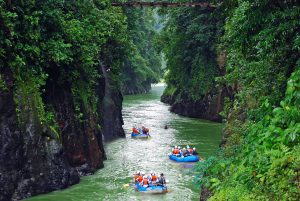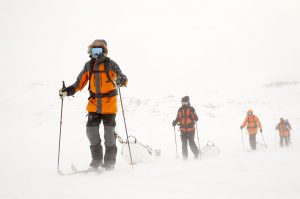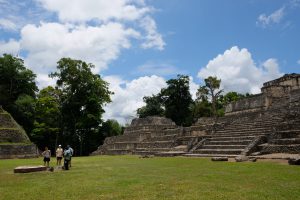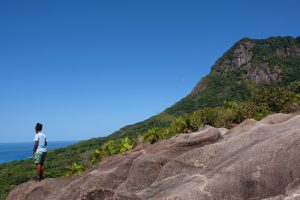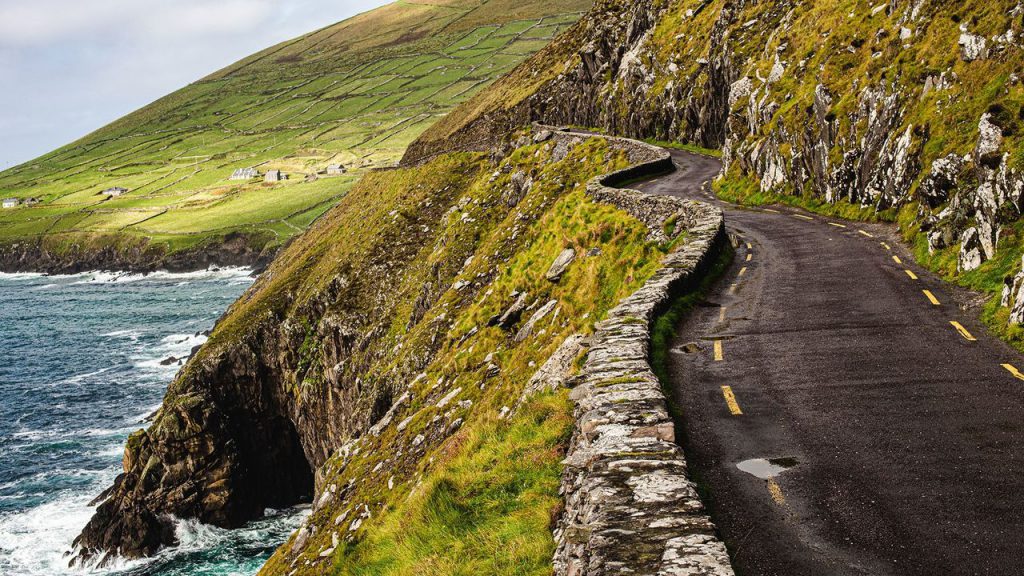
Coastal road on the Dingle Peninsula. Credit: Karonlina Wiercigroch
County Kerry and West Cork are bastions of Celtic culture, their five Atlantic peninsulas home to historic monasteries and storied islands. Tracing this shoreline on a week-long road trip showcases Ireland at its most rugged, ancient and surprising
Read the article online at nationalgeographic.com
Down in Ireland’s south west, the land frays to tattered peninsulas that splay into the Atlantic like five mighty, crooked fingers. Around them, little islands — some inhabited, many not — stand sentinel among the thrashing waters, fragments of the mainland half-lured to sea by the mercurial wiles of the horizon. This stark coastline, stretching from County Kerry into rural West Cork, has the unmistakable feel of a frontier.
“This is where Europe squares up to the rest of the world,” my guide, Ciarán Thornton, confirms, adjusting his flat cap, to which is pinned a kestrel feather. “Just off this coast, the ocean shelf vastly drops away as the Eurasian Plate goes out to meet tectonic North America. You can feel it even without knowing it. There’s something almost magical about liminal places like this. It’s hard to put into words.”
It’s still early — the first morning of my week-long road trip tracing southwest Ireland’s coastal edges — when Ciarán and I climb out of the car in the former smugglers’ cove of Derrynane Harbour, at the tip of Kerry’s Iveragh Peninsula. We’re met by a briny slap of ocean air, an excitable sheepdog and a small flotilla of fishing boats floating upon a hazy bay. Somewhere out of sight is our destination: the archaeological marvel of Skellig Michael, an island settled by a dozen Christian monks in the sixth century and, today, abandoned to seasonal bird colonies — and tourists.
Visiting isn’t easy, though. To preserve the integrity of the site, only 15 small vessels are licensed to take people out (between May and October) and these tours — which sell out far in advance — are regularly called off due to dangerous ocean swells. “Someone has brought some luck along today. This is the first day in almost a week we’ve gotten the green light,” skipper John O’Shea says, as eight passengers and three dogs pile off the jetty into his boat.
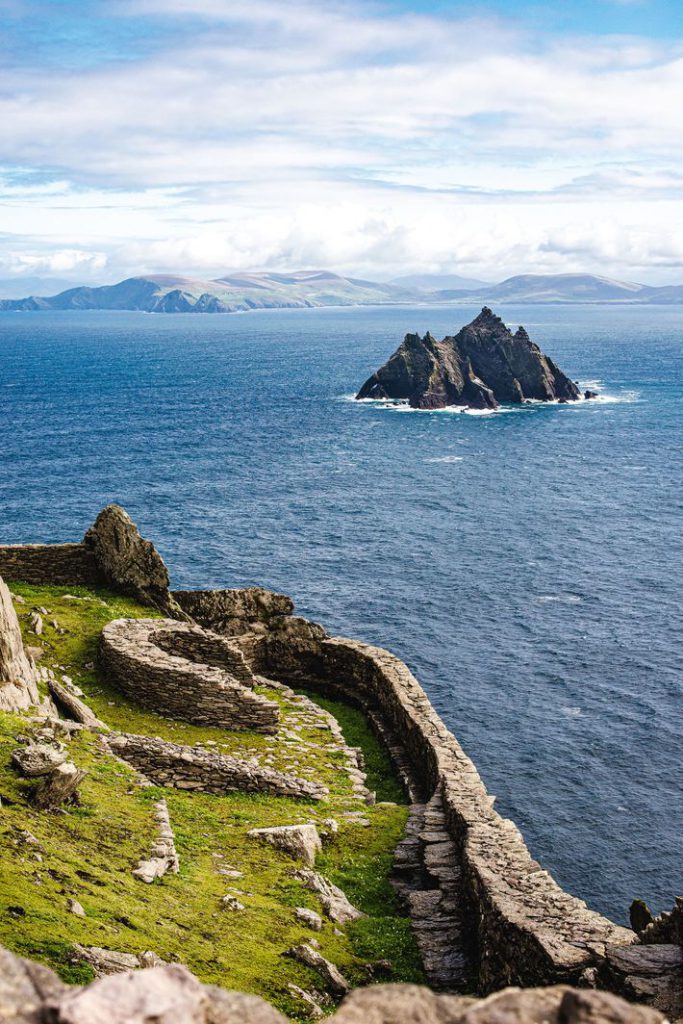
The view across to Little Skellig and the mainland from the sixth-century monastery on Skellig Michael. Credit: Karolina Wiercigroch
Life jackets are passed around, the boat is unmoored in a flurry of slackened ropes, an engine sputters into life and we’re away. In his captain’s cabin, John is steering with one hand and warming hunks of bread on a hob with the other. “Tea?” he asks as I squeeze in to join him, disturbing a sleeping dog as I do. “This is practically my second home,” he says, in an attempt to explain the jumble of possessions and pillows. “This was my father’s fishing boat. He was the first to offer proper tours to the islands, back in the ’70s. Business is much busier now.” Much of the reason for this upturn in Skellig Michael’s fortunes can be attributed to its star turn in the 2017 film Star Wars: The Last Jedi. “You haven’t brought a Jedi costume or lightsaber, I see,” John remarks dryly.
I spend most of the hour at sea on the prow with Luna, the Border Collie — “our chief dolphin spotter”. It’s a quiet morning for marine life: Luna’s barks only alert us to one seal, glossily flipping about in the waves. Soon the pyramidal outline of Skellig Michael appears on the horizon, its natural spires and buttresses crystallising into view as we grow closer. It strikes me as an untamable place; still simmering from the violent geology that formed it. Even on a calm day, tides smash into its barnacled cliff faces — sending up geysers of white spray — and gales compete to dislodge stones.
The island unsettled the Irish playwright George Bernard Shaw when he visited in 1910: he described it to a friend as “an impossible, mad place … I tell you the thing does not belong to any world that you and I have lived and worked in: it is part of our dream world.”
The intensity of faith that drove generations of monks — for some 600 years — to make this austere splinter of rock their home, is almost incomprehensible.
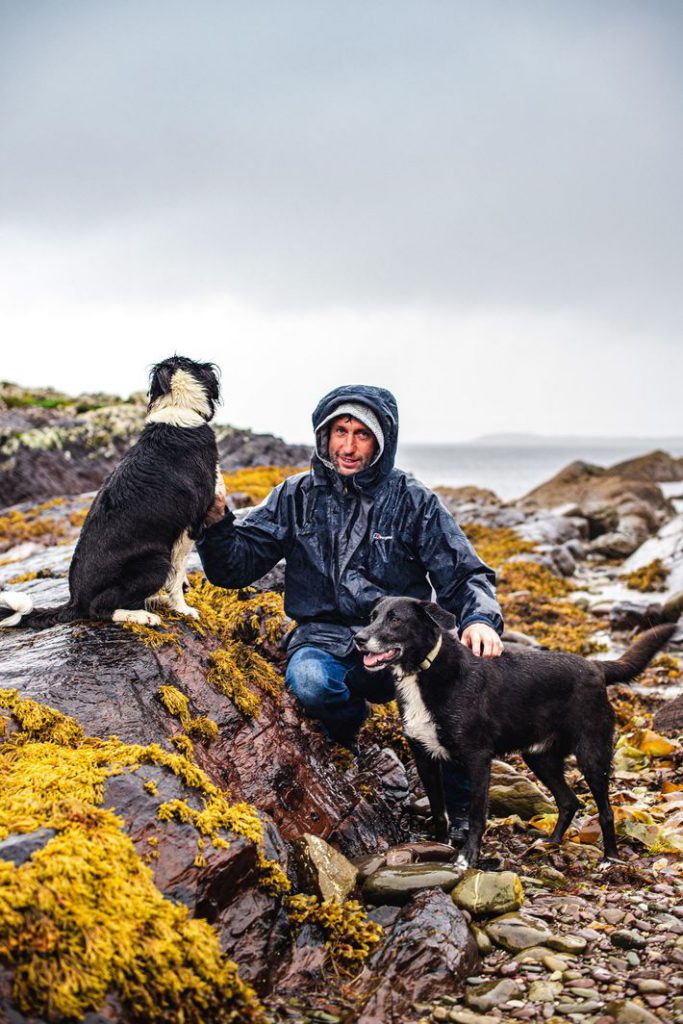
John O’Shea, seen here with his dogs, Watson and Luna, has been sailing visitors to the Skellig Islands for over two decades. Credit: Karolina Wiercigroch
“You have to understand that early Celtic Christianity was very different — you didn’t need a church to be close to God, or a priest,” Ciarán explains. “These men were influenced by the Desert Fathers, like Saint Anthony, who lived in solitude outside civilisation. For them, the divine was in nature. This was a place they could meditate upon creation.”
Ireland became an important centre of learning and mysticism following the introduction of Christianity to Ireland in the fifth century by Saint Patrick; the ruins of nine such island monasteries have been identified off this stretch of coast, but none as well-preserved as Skellig Michael.
At the top of 618 uneven steps — a testing 600ft climb that, according to our health and safety briefing, has occasioned a handful of recent fatalities — we emerge onto a terraced shelf. Behind us is a low, grassy ‘saddle’ and a closed-off path that rises to a hermitage built, daringly, on an exposed ledge on the most southerly peak. Up ahead is the monastery compound: a clutch of beehive-shaped drystone huts, known as clocháin, a cemetery of rustic crosses and the eastern wall of a medieval abbey. Its remaining window looks out to sea; through it, I can see the outline of Small Skellig, home to the world’s largest gannet colony. Guillemots and razorbills trail their shadows across slopes dusted with wildflowers and puffin nests. I didn’t know a place this beautiful or thought-provoking existed so close to home, just across the Irish Sea.
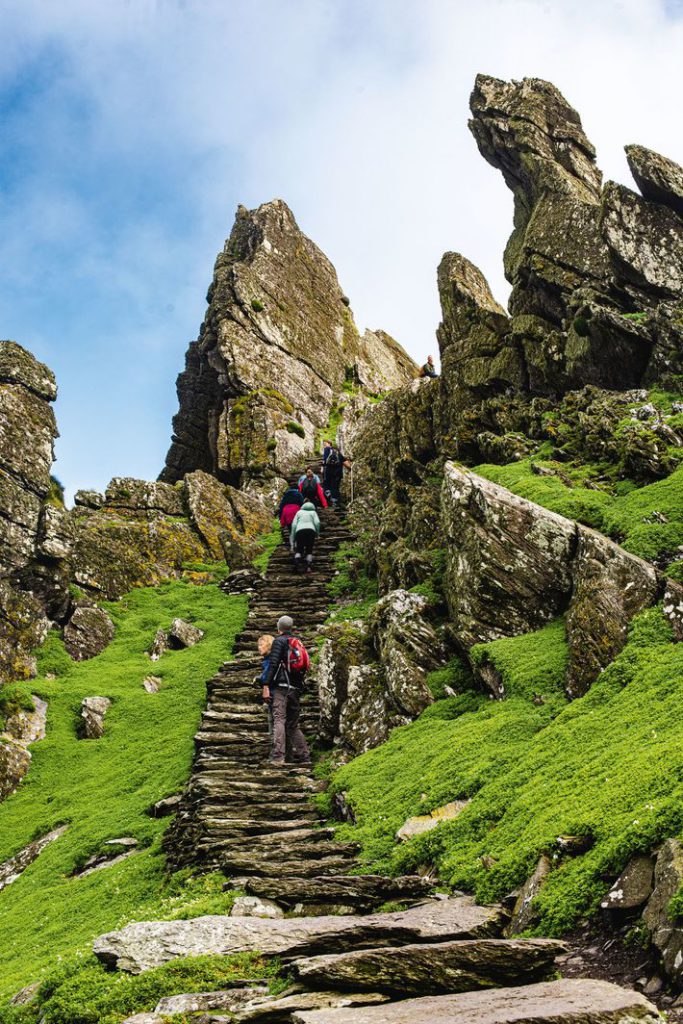
Visitors scale treacherous steps on Skellig Michael known as ‘the way of Christ’. Credit: Karolina Wiercigroch
Catherine, a resident guide — bronzed from the summer, wearing practical, cut-off shorts — answers visitors’ questions and shares some of the island’s secrets. She tells us that due to the fragility of the ecosystem (not to mention the perilous topography), guests aren’t permitted to explore beyond the steps and monastery walls, but assures us that every jutting rock and hidden plateau of the island would’ve been familiar to the monks. “Each crag became a Station of the Cross,” Catherine says. “Imagine throwing open your arms towards the ocean in worship. This was the edge of the known world back then, remember — there was no America yet.”
Throughout the tourist season, Catherine lives in a cabin on the island while working her fortnight-long stints. “I always try to take in the sunrise or sunset. Last night, I woke up and saw the moon had cut a path of silver through the sea and the whole site was lit up in monochrome. I know it’s said too often, but there really is magic here.”
Back on the boat, John is frying up mackerel for us — he’d been busy with his lines while we were exploring. It’s the best fish I’ve ever tasted — mouthwatering and buttery soft. It’s with much reluctance that I share some with Luna, before rinsing my hands in the cold surf. I feel immeasurably grateful for the trip; enriched, smiling and a little sunburnt. I notice our captain appears to have come alive after a day at sea, too. His tan has deepened and his eyes twinkle like sun-brightened shallows. Skellig Michael may have lost its monks, I think, but it still has its pilgrims.
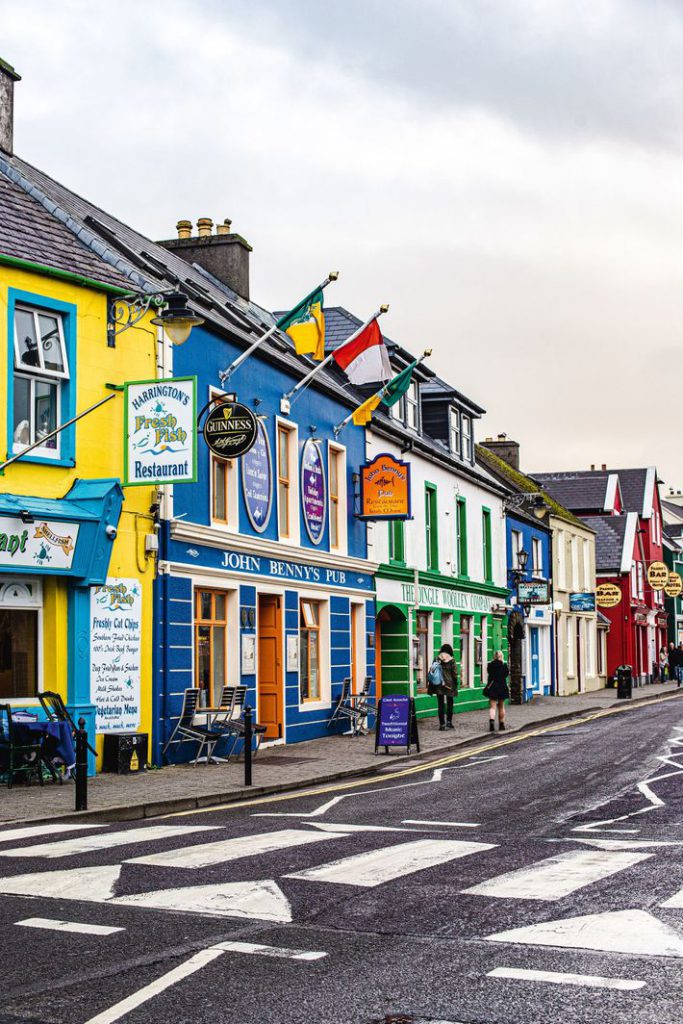
Colourful street in Daingean Uí Chúis, more commonly known as Dingle. Credit: Karolina Wiercigroch
Dingle all the way
It’s raining hard when we set out from Ventry Bay the next morning. Cormorants move like shadows in the shifting mists and, on the wet sand, the retreating tide has laid out large fans of knobbly kelp. Elated by the climate, Ciarán strides off apace. I trundle in his wake, beginning to doubt the ‘waterproof’ claims of my outdoor wear.
We’re heading out on a half-day hike of a section of the Dingle Way, the 101-mile trail that follows the coast of the Dingle Peninsula — the western part of which is one of two designated Gaeltacht (Irish-speaking) regions in County Kerry. We’d spent the previous night in the main town, Dingle (Daingean Uí Chúis, in Irish), an atmospheric cat’s cradle of harbour lanes, where live music spills out of family-run pubs, candles flicker in the windows of seafood restaurants, and shops selling knitted goods stay open late. The county relies heavily on tourism (its stunning 120-mile Ring of Kerry driving route is flooded with coaches in the hotter months) but I’m finding that the region absorbs the crowds well. “It hasn’t lost its charm,” Ciarán agrees, “and it’s easy to get out and alone into nature quickly — that’s part of its magic. There are areas that feel untouched by time.”
Ciarán isn’t from these parts — he grew up in the mountains of County Wicklow — but has met me in the south west for a bespoke, private version of Wilderness Ireland’s Hiking and Island Hopping Cork and Kerry group tour. He hums the ballad Come by the Hills as we climb through wetlands, past burial mounds and ringforts, towards Eagle’s Rock. Ciarán is only in his late 20s but has an encyclopedic grasp of the country’s complex mythologies and flora — and thoughtful takes on our times. “You’re visiting at a special time. Ireland’s reawakening, discovering itself, figuring out its identity,” he tells me. “We’re an ancient country but, in terms of independence, also barely 100 years old. For a while, we leaned into the whole ‘leprechaun’ thing,” he says, skewering the use of corny motifs taken from folklore and splashed across keyrings and fridge magnets. “But people are finding that we have a real connection to the land, the trees, the rocks, the language, our stories. We’ve been through a lot, but it wasn’t lost. We’d just forgotten.”
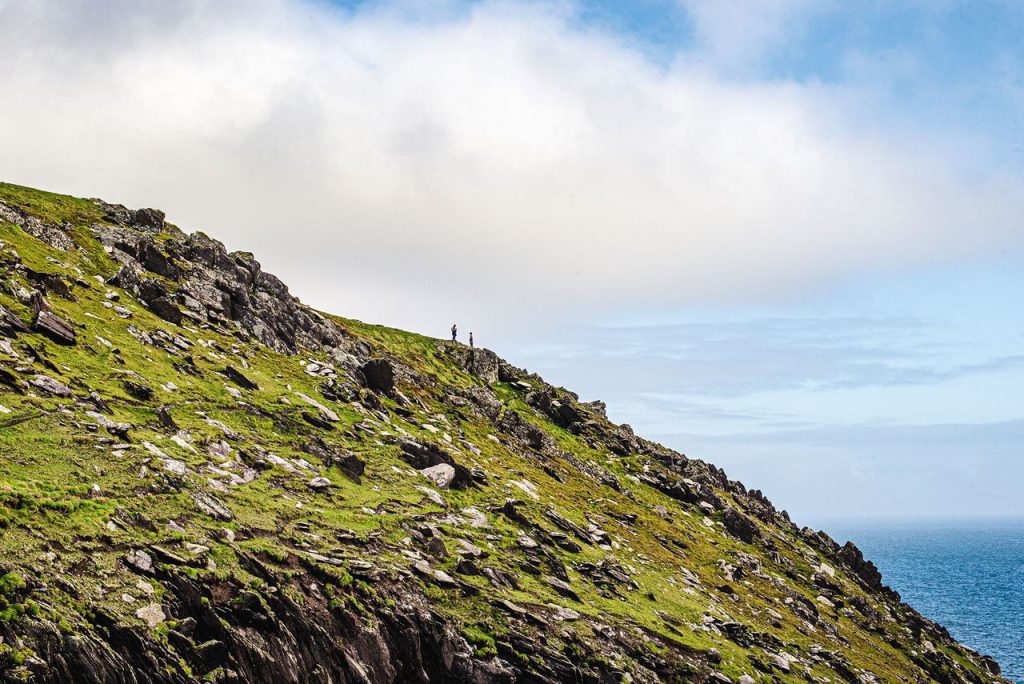
Walkers scale the cliffs of Dunmore Head, Dingle Peninsula. Credit: Karolina Wiercigroch
“Throughout our history, invaders came for glory, because it was a holy land, a famous land, a fertile land, or whatever their reason,” Ciarán continues. “But they all fell in love with it and mixed in. That’s the true character of the land and the people: something very old and accepting. And it’s surfacing again. You need only look at our politics.”
In 2015, Ireland legalised same-sex marriage — becoming the first country in the world to do so by popular vote; two years later, it elected as premier Leo Varadkar, a trailblazing young, gay politician and the son of Indian immigrants; and in 2018, a referendum resulted in a landslide win to legalise abortion. “But,” Ciarán says, adding a humble caveat, “these are my just philosophical musings based on little more than walking in the hills.”
Our walk ends with hot chocolate and hearty soup at clifftop coffeeshop Caifé na Trá, from whose windows we’re gifted expansive views across a choppy strait to the Blasket Islands. The weather has cleared and we can see the main island’s wide smile of a yellow beach is dotted with seals basking in the sun. Below us, a handful of brave surfers chase waves to shore. In my hands, I’m turning over a piece of slate bought from a local artisan; it has the word ‘love’ carved into it in Ireland’s ancient Ogham script. Together, the markings look like a broken feather, or a tree with short, erratic limbs. Inscriptions like these — some dating back to the fourth century — can still be seen on some of the almost 100 standing stones across Dingle. Ciarán explains these are markers proclaiming the name of the local clan.
“West Ireland is one of the last places where you can still imagine what Celtic Europe was like before the Roman Empire,” he explains, as the waitress swings by with seconds. Latin culture only arrived here later, with English rule and the Roman Catholic Church. “The Gaelic language survived in rural pockets like this that were hard to colonise,” Ciarán continues. “And people kept the culture alive through songs and the stories. That couldn’t be subdued. You can’t stop someone singing a song, can you?”
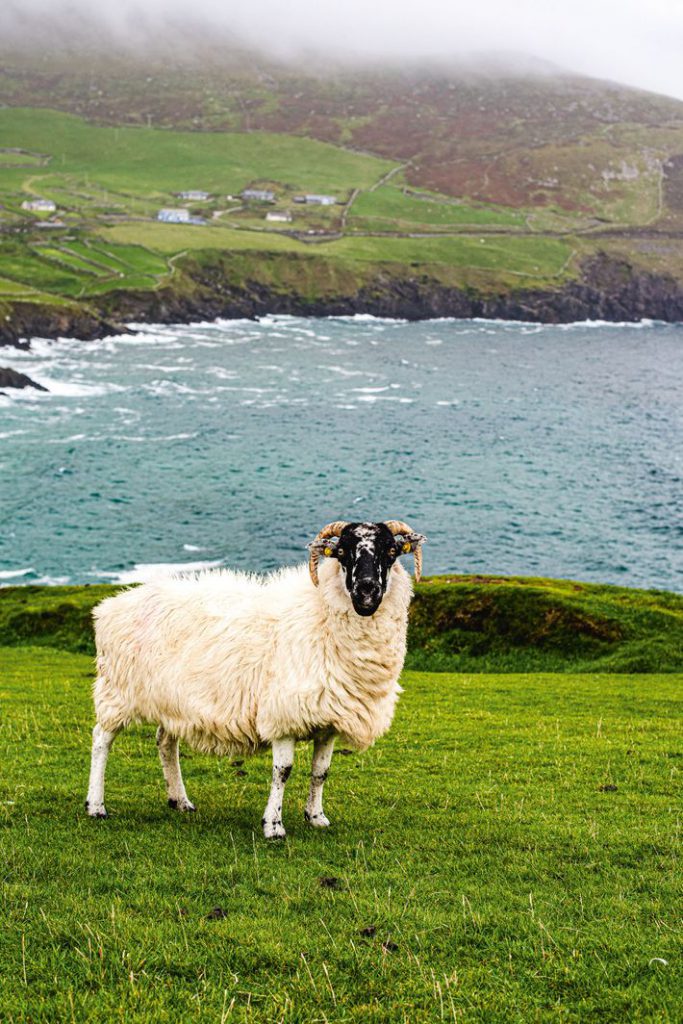
A ram in a coastal pasture, Dingle Peninsula. Credit: Karolina Wiercigroch
The following day, we head to a lesser-visited part of the peninsula. The hedgerows around the village of Annascaul are heavy with the fantastical remnants of late summer: shocks of fuschia bells and plump bilberries. A bauble-round robin flies around us, its wings purring in the warm air. “It’s good to have a guide in Ireland,” Ciarán insists. “This walk would just be a footnote in a guidebook, if that. And you’d miss all this.” The Con Dubh Loop Walk is one of his favourites as it has “maybe the quietest places in Ireland”. We explore a rustic graveyard of cairns and crypts, where many inscriptions have been buffed away by time and the elements. Interestingly, here lies early 20th-century explorer Tom Crean, a local lad who signed up for three legendary Antarctic missions, including Robert Falcon Scott’s Terra Nova Expedition (1910-13), and was aboard the ill-fated Endurance with Irish Antarctic explorer Ernest Shackleton. Still standing today, in Annascaul, is the pub Crean founded when he retired, the South Pole Inn, now plastered with portraits, cuttings and medals celebrating his exploits.
Before the path returns us to the village, it takes in Annascaul Lake — a pool of quicksilver in the crook of a valley dotted with Fresian cows and curly horned sheep. We plonk ourselves down on the bank, among the bell heathers. “Appreciating nature, for me, is a process of unlearning, trying to find a state of wonder, curiosity, unknowing,” Ciarán confesses. “You may think you know a place, a scene — but try to look closer.”
The wild west
I bid Ciarán goodbye in the pretty tourist town of Killarney and drive on along empty coastal lanes, until I cross into County Cork. The landscape is so rugged, rural and untouched, it’s easy to believe you’re the first traveller to stumble upon it. Unpaved roads, braided across the Beara Peninsula, bring me to postcard-perfect, pastel-hued Allihies, with its dramatic ruined engine houses — a reminder that this was once a thriving copper mining village. And in the fishing port of Castletownbere, I eat more than I can justify at the Beara Coast Hotel: buttery scallops, line-caught fish and salty samphire, followed by a platter of local cheeses (Milleens, Durrus and Beara Blue). Afterwards, I sip pints of Guinness with locals in MacCarthy’s Bar. A tense game of Gaelic football is unfolding on the television, and I’m accepted into the fray with the cheerful question, “Who are you shouting for?” from the barmaid.
The next day, I press on, parking the car and taking the tiny wooden cable-car across to Dursey Island for a hike. As old cables crank the carriage across the seething strait below, I notice a bottle of holy water from Knock and a psalm pinned to the wall — presumably to reassure travellers of a nervous disposition. “I’ve also got a bottle of whiskey if you need a little extra courage,” a passenger sitting opposite me jokes.
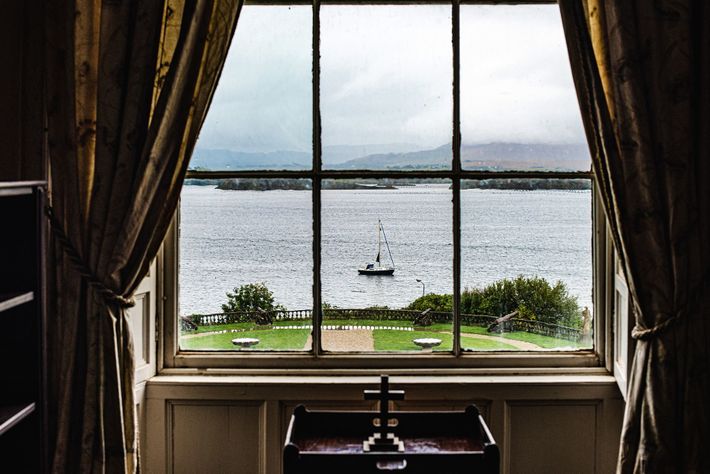
Bantry House, a stately home and museum with guest rooms overlooking Bantry Bay on Sheep’s Head peninsula; it’s still run by descendants of its 18th-century founders. Credit: Karolina Wiercigroch
The island is a revelation: lobster crates and tame donkeys decorate cottage gardens; a ruined abbey, said to have been built by the monks of Skellig Michael, haunts a cliff; stonechats click and flutter among hedges of tasty blackberries. During the summer, I read, it’s a great spot for whale-watching. Dursey, I also discover, has a tragic history that demands to be heard: in 1602, Queen Elizabeth I’s forces massacred 300-odd residents — men, women and children of the O’Sullivan clan. Some were thrown from the cliffs, others jumped.
This sobering story stays with me, but I pick up brighter ones, too, first at Garinish Island — home to the historic Bryce House and its Italianate gardens, which hosted some of Ireland’s great 20th-century thinkers before becoming a museum — and later in Bantry. I stay in the little town’s crowning glory, Bantry House, a stately home with plush guest rooms, still run by descendants of its 18th-century founders. After the house closes to day guests, I wander through the drawing rooms admiring the collection of art, gilt mirrors and tapestries before curling up by the roaring fireplace (with a tipple from the honesty bar) and reading about its former residents.
The final flourishes of West Cork take me through the wildest landscapes I’ve seen yet, to places that feel unmoored from the rest of Europe. Driving the precarious coastal tracks towards the tip of the Sheep’s Head peninsula, I’m reminded of one of Ciarán’s sayings: ‘There are no straight roads in Ireland, or straight answers’. Astonishingly, at the tip of the headland is a cafe — Bernie’s Cupán Tae. Bernie Tobin’s improbable establishment is often called ‘the teashop at the end of the world’, and after my bumpy journey it certainly feels like I’ve reached a remote outpost. Scones slathered with homemade jam set me up to cruise back down the peninsula and follow the south west’s pinky finger up to the forlorn signal station at Mizen Head.
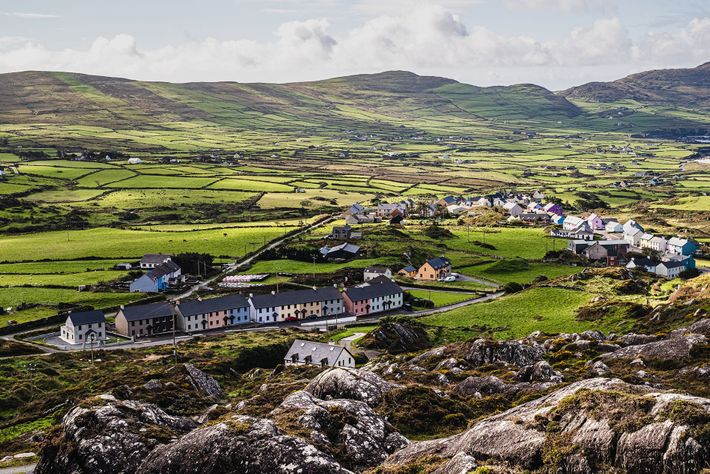
A patchwork of fields near Allihies on the Beara peninsula. Credit: Karolina Wiercigroch
On my final evening, I meet Jim Kennedy, of Atlantic Sea Kayaking, beside the saltwater inlet of Lough Hyne. There are gutsy swimmers taking a late-summer dip as we paddle out in kayaks, the heavens darkening. “There’s depth to West Cork; once you peer beyond the top layer you can feel this whole other world,” Jim says. “It’s the best place to taste Ireland, but it’ll never be touristy — for one thing, you saw our roads.” My guide is a champion kayaker who’s been running tours in West Cork for 25 years but still ranks as a ‘blow-in’, according to local standards.
We pause and float in the darkness, listening to the heavy breaths of a nearby seal. “Look closely at the water,” Jim says softly. I see that my moving oar is glittering with blue sparks. How had I not seen this before? I look closer still and see the reeds and fish are dancing with light, too. I plunge my arm in and bring up a glittering gauntlet. I thought you had to travel to the Caribbean to see bioluminescence like this, I say. “Well,” Jim says, laughing kindly, “maybe you’ve heard: there’s a little magic here.”
Essentials
Getting there & around
Ireland’s south west can be accessed via Shannon Airport in County Kerry or Cork Airport in County Cork, both of which are typically served from the UK by airlines including Ryanair.
Average flight time: 1h30.
Car hire is essential unless joining a group tour.
When to go
Ireland is a year-round destination but summer and autumn offer the best weather (July and August average 15C). Boats to the Skellig Islands typically run from May-early October; booking ahead is essential. Due to coronavirus, Skellig Michael won’t be open until 2021. The island has no toilet or cafe facilities, and it’s advisable to bring study shoes, a packed lunch and waterproofs.
More information
ireland.com
otherworldnatureconnection.com
How to do it
Wilderness Ireland offers the week-long Hiking & Island Hopping Cork and Kerry from €1,870 (£1,675) per person. Includes guided hikes along the Wild Atlantic Way, a visit to Skellig Michael and two other islands, visits to local craftspeople, and six nights’ accommodation in local hotels, all B&B. Group and bespoke tours available.
Published in the Jul/Aug 2020 issue of National Geographic Traveller (UK)





